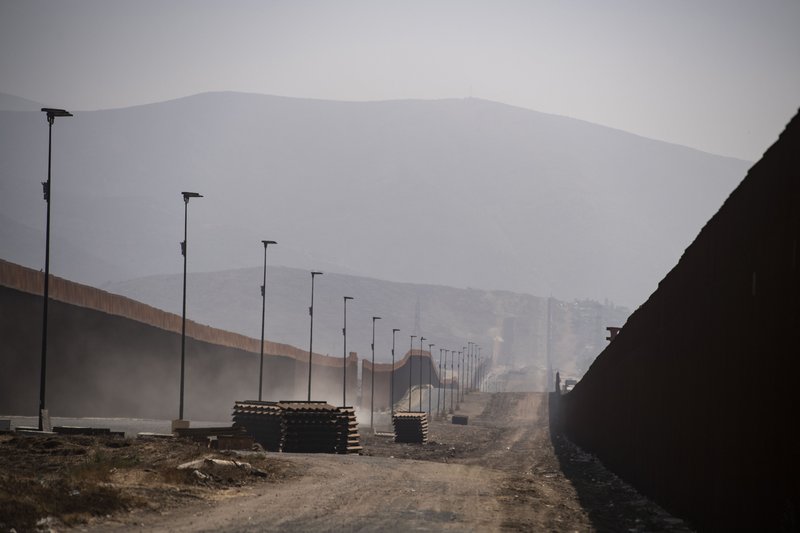SAN DIEGO -- Smuggling gangs in Mexico repeatedly have sawed through new sections of President Donald Trump's border wall in recent months by using commercially available power tools, opening gaps large enough for people and drug loads to pass through, according to U.S. agents and officials with knowledge of the damage.
The breaches have been made using a popular cordless household tool known as a reciprocating saw that retails at hardware stores for as little as $100. When fitted with specialized blades, the saws can cut through one of the barrier's steel-and-concrete bollards in a matter of minutes, according to the agents, who spoke on the condition of anonymity because they were not authorized to speak publicly about the barrier-defeating techniques.
After cutting through the base of a single bollard, smugglers can push the steel out of the way, allowing an adult to fit through the gap. Because the bollards are so tall -- and are attached only to a panel at the very top -- their length makes them easier to push aside once they have been cut and are left dangling, according to engineers consulted by The Washington Post.
The taxpayer-funded barrier -- so far coming with a $10 billion price tag -- was a central theme of Trump's 2016 campaign, and he has made the project a physical symbol of his presidency, touting its construction progress in speeches, ads and tweets. Trump has increasingly boasted to crowds in recent weeks about the superlative properties of the barrier, calling it "virtually impenetrable" and likening the structure to a "Rolls-Royce" that border crossers cannot get over, under or through.
The smuggling crews have been using other techniques, such as building makeshift ladders to scale and overtop the barriers, especially in the popular smuggling areas in and around San Diego, according to nearly a dozen U.S. agents and current and former administration officials.
Mexican criminal organizations, which generate billions of dollars in smuggling profits, have enormous incentive to adapt their operations at the border to new obstacles and enforcement methods, officials say.
The U.S. government has not disclosed the cutting incidents and breaches, and it is unclear how many times they have occurred. The U.S. Customs and Border Protection agency declined to provide information about the number of breaches, the location of the incidents and the process for repairing them. Matt Leas, a spokesman for the agency, declined to comment, and the agency has not yet fulfilled a Freedom of Information Act request seeking data about the breaches and repairs. The U.S. Army Corps of Engineers, which oversees the private contractors building the barrier, referred inquiries to the border agency.
Some of the damage has happened in areas where construction crews have yet to complete the installation of electronic sensors that, once operational, will more quickly detect the vibrations sawing produces on the bollards, the officials said. They also said one of the main advantages of the steel bollard system -- which stands between 18 and 30 feet tall -- is that damaged panels can be easily repaired or replaced.
In the San Diego area, smugglers have figured out how to cut the bollards and return them to their original positions, disguising the breaches in the hope that they will go unnoticed and can be reused for repeated passage. Agents said they have learned to drive along the base of the structure looking for subtle defects, testing the metal by kicking the bollards with their boots.
If damage is detected, welding crews are promptly sent to make fixes. The smugglers, however, have returned to the same bollards and cut through the welds, agents say, because the metal is softer and the concrete at the core of the bollard already has been compromised. The smugglers also have tried to trick agents by applying a type of putty with a color and texture that resembles a weld, making a severed bollard appear intact.
Agents in California and Texas said smuggling teams also have been using improvised ladders to go up and over the barriers, despite the risk of injury or death from falling; the tallest barriers are approximately the height of a three-story building. Some of the teams deploy lightweight ladders made from metal rebar, using them to get past the "anti-climb panels" that span the top of the barrier.
The Trump administration has so far completed 76 miles of new barriers, all of it in areas like San Diego where the structure has replaced older, shorter and, in some cases, dilapidated fencing.
Another 158 miles of barrier is under construction, according to the Customs and Border Protection agency, and the agency said 276 miles are in a "preconstruction" phase.
The administration remains on track to complete 450 miles of barriers by the end of next year, Customs and Border Protection acting commissioner Mark Morgan said last week. The latest construction data obtained by The Washington Post show that the administration has finished just 2% of the barrier planned for stretches of border in Texas, where plans call for 166 miles of new fencing. Almost all of that barrier would be built on private land that the government has yet to acquire.
A Section on 11/03/2019
